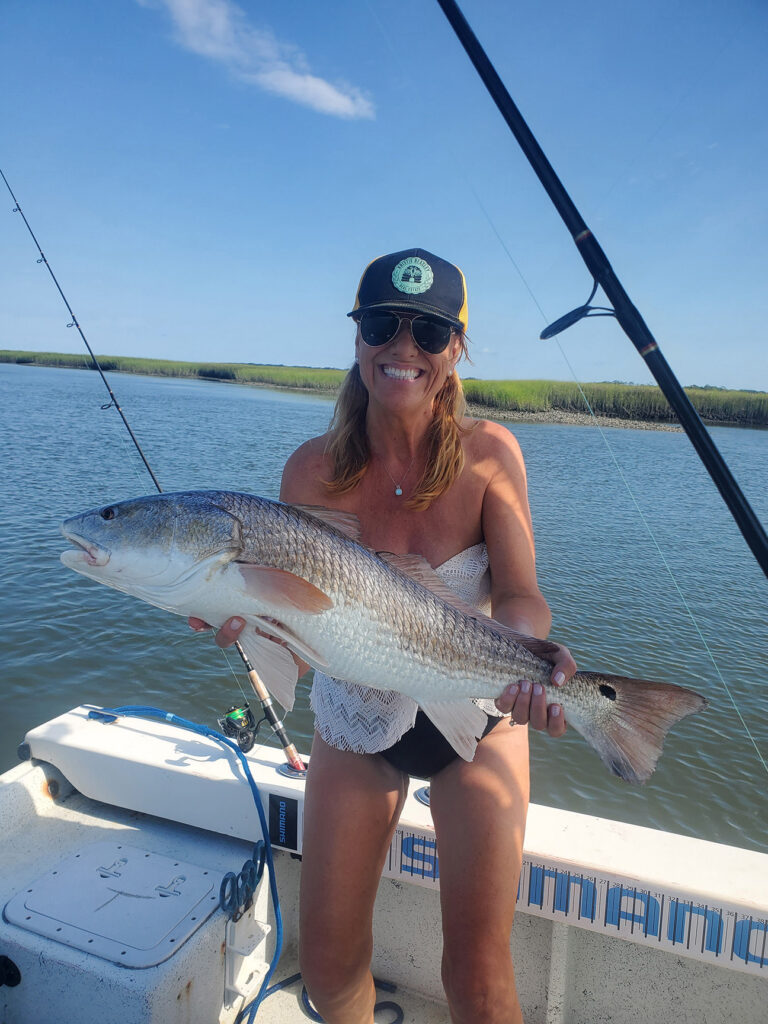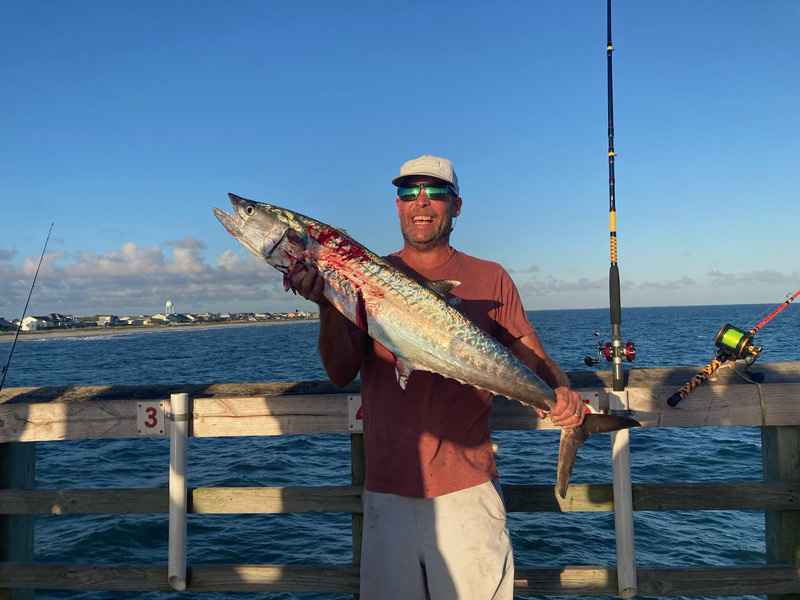Southport/Oak Island – August 2024
Matt, of Dutchman Creek Bait and Tackle, reports that surf anglers have been catching a mixed bag of whiting, croakers, and pinfish.
Inshore, the occasional red drum and some speckled trout are being caught, though this has mostly been from anglers out on the water really early. Overall, the fishing has slowed down a lot once the sun is up, and then it picks back up in the evening hours.
Anglers fishing from the piers have found a couple tarpon and jack crevalle with live baits.
When the opportunity to head outside the inlets arises, boats are finding spanish mackerel and scattered king mackerel. The kings have been spread out from the beachfronts out to 10 miles.
Offshore runs have produced mahi, though water temperatures are really hot and the mahi bite is not anything one would call consistent.
Back inside, the ICW and Cape Fear Rriver have produced a bunch of red drum and catch-and-release flounder.
Some speckled trout are mixed in, though this action is strictly a really early or late bite.
Garrett, of Oak Island Sporting Goods, reports that surf anglers have been finding black drum alongside pompano, whiting, and some bluefish.
Spanish mackerel are around, but the fish have been mostly pushed out to deeper water. With cleaner water, though, the spanish should return to the beachfronts and surf zone.
Inshore anglers have been catching both black drum and red drum while fishing with live shrimp (both species) or cut mullet (for the reds).
Some sheepshead are also being caught by those fishing shrimp or crabs around docks and pilings.

Kristie Beasley, of Southport, caught (and released) this 30.5″ red drum in her home waters using a finger mullet.
Robert, of Reelin’ Pelican Fishing Charters, reports that red drum are really keyed in on Carolina-rigged live bait, whether menhaden, finger mullet, or mud minnows. Target the reds up along the grass banks on higher tides, and then drop back out to channel mouths or cuts when the water is lower.
Fishing the morning or evening hours is producing some speckled trout on the same Carolina-rigged live baits.
Numerous black drum are being caught on shrimp.
Trips outside the inlet are seeing that the spanish mackerel action isn’t anything special in either numbers or sizes.
There’s a spadefish bite on the reefs and nearshore wrecks.
Hunter, of Dockside Fishing Charters, reports that mullet have been showing up in better numbers and sizes. Consequently, the red drum are now focused more on mullet than the menhaden. Anglers targeting reds have found the better action to be right around high tide and the early stages of the fall, and the more productive areas are grass banks on the high tide and then working docks once the water is below mid-tide.
Anglers out in the early morning are having some success catching speckled trout on topwater plugs or while floating live shrimp. For the best chance at a summer trout, work shorelines with shell banks and deep holes nearby.
Steve, of Reel Em Up Charters, reports that anglers have been catching a lot of red drum around grass banks, oyster rocks, and ledges off nearby sandbars. The class of fish has been in the 22-27” range.
Fishing during the falling tide has been better, and with a bunch of good-sized finger mullet now in the area, the red drum are keyed in on mullet as the top bait option.
If out on the water in the early mornings, some speckled trout are also mixed in the same areas as the red drum. The slightly cooler water temperatures are key when targeting trout.
Flounder are mixed in all over the place and will hit just about any live bait put on the bottom.
Black drum fishing is seeing keeper-sized fish as much more common. Target the deeper water spots (4-10’ depths) around structure in the creeks.
Sheepshead are being caught with fiddler crabs around deeper docks and pilings in the creeks and out along the ICW.
Mark, of Angry Pelican Charters, reports that live bait has been plentiful, and with all of this bait available (both for anglers and the fish), bait fishing has been the go to.
Some large spanish mackerel and a few king mackerel can be found within sight of the beach.
Shark fishing has been excellent, with anglers finding several species, including large hammerheads. The mixed bag of toothy critters also includes spinners, fine-tooth, and sharp nose sharks all feeding in shallower (15-35’) waters. Live menhaden have been best.
Ryan, of Fugitive Charters, reports that those targeting the beachfronts are continuing to find spanish mackerel and plenty of sharks.
With the few opportunities to get further offshore (10-20 miles), anglers have been able to catch king mackerel on both live baits and dead cigar minnows.
Bottom fishing remains a great summertime option, with the best bite starting around 35+ miles. Once in this depth (and deeper), anglers can find the keeper tropical grouper species, large vermilion snapper, and black sea bass.
Troy, of Ocean Crest Pier, reports that bottom fishing efforts are producing flounder, baby sharks, and croakers.
The spanish mackerel and king mackerel action has been slow due to dirty water.
Cindy, of Oak Island Pier, reports that bottom fishing anglers have been catching a bunch of good-sized croakers.
A few spanish mackerel are being caught, but the action better is always when there are cleaner water conditions.
Plenty of small blacktip sharks are around.






